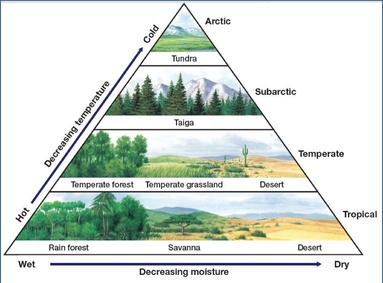Responses to the Environment Study Guide
Introduction
Behaviors are responses to stimuli. They can either be instinctual/innate behaviors, which are not influenced by the environment, or learned behaviors, which are influenced by environmental changes. Instinctual behaviors include mating systems and methods of communication. Learned behaviors include imprinting and habituation, conditioning, and, most powerfully, cognitive learning.
Ecology and the Biosphere:
1. What are the general characteristics of the terrestrial (land) and aquatic (marine) biomes?
- Biomes are defined by their temperature and precipitation and can be impacted by factors such as latitude, elevation, nearby water, ocean currents, topography, vegetation, pressure systems and more.
- 8 main terrestrial biomes, spread around the world:
- The major ocean biomes are the oceans, coral reef, and estuaries.
2. How can changes in abiotic and biotic factors alter an ecosystem?
-
Abiotic factors are those that are non living, such as rocks, sunlight, temperature, and ocean currents for marine ecosystems. Changes in abiotic factors can limit or increase habitats for the organisms that live there. For example, more precipitation may limit which species can thrive, but also allow new ones to be introduced.
-
Biotic factors are living factors of an ecosystem, such as the plants and animals that live there, named flora and fauna respectively.Changes to both biotic and abiotic factors of an ecosystem can change levels of competition among organisms and species (more on this later).
Ecosytems:
1. Understand how energy flows flows through an ecosystem with food chains and foods webs.
-
Food chains list organisms in an ecosystem that feed off of each other. At the bottom are producers, plants that convert sunlight to mass. The second tier (or trophic level) of the food chain is called the primary consumers, and is composed of herbivores who eat the primary producers. After them comes secondary consumers, and so on. A food web is simply a combination of multiple food chains to represent a fuller view of an ecosystem.
-
The energetic hypothesis, also known as the 10% rule, explains how food webs (and by extension, ecosystems) are limited by size. Only 10% of energy is passed up to the next trophic level: the primary consumers only get 10% of the energy contained in the matter of the plants they eat, with the remainder lost to heat and other body functions plus the needs of the plant. Secondary consumers get 10% of the energy of the primary consumers. This puts a limit on the number of trophic levels an ecosystem can support, usually not more than 6.
-
One of the most important parts of an ecosystem are the decomposers. Decomposers like fungi recycle the dead matter back into the soil for new plants to grow.
2. Differentiate between gross primary productivity and net primary productivity.
-
Gross primary productivity is simply a measure of the rate of photosynthesis. However, because not all of this energy can move up the trophic levels (as the plant has to use some energy for its own growth) biologists calculate the net primary productivity, which is the removal of respiration from photosynthesis rates.
-
It’s better to have a higher net primary productivity than a gross primary productivity, because that means that there is enough energy left over from the plants to support an ecosystem. If the gross primary productivity is higher than the net primary productivity, the plants are not producing enough energy to support an ecosystem.
3. Know (don’t memorize) the biogeochemical processes and be able to explain how changes impact the environment.
- Biogeochemical processes, such as the carbon, nitrogen, and water cycles, rotate these molecules through the environment in a variety of ways. Higher levels of carbon, nitrogen, and water generally allow for more species to thrive, increasing biodiversity.
Conclusion
- Biomes are defined by their temperature and precipitation, and can be impacted by factors such as latitude, elevation, nearby water, ocean currents, topography, vegetation, pressure systems, and more.
- Abiotic factors are those that are non living, such as rocks, sunlight, temperature, and ocean currents for marine ecosystems.
- Biotic factors are living factors of an ecosystem, such as the plants and animals that live there, named flora and fauna respectively.
- Food chains list organisms in an ecosystem that feed off of each other. At the bottom are producers, plants that convert sunlight to mass. The second tier (or trophic level) of the food chain is called the primary consumers, and is composed of herbivores who eat the primary producers. After them comes secondary consumers, and so on.
- A food web is simply a combination of multiple food chains to represent a fuller view of an ecosystem.
FAQs
1. Which model concentrates on the responses an organism makes to its environment?
Behavioral model concentrates on the responses an organism makes to its environment
2. What is the term for the sum total of an animal’s responses to its environment?
Behaviour is the term for the sum total of an animal’s responses to its environment
We hope you enjoyed studying this lesson and learned something cool about Ecology: Responses to the Environment! Join our Discord community to get any questions you may have answered and to engage with other students just like you! Don’t forget to download our App to experience our fun VR classrooms – we promise, it makes studying much more fun 😎
Sources:
- Reece, J. B., & Campbell, N. A. (2011). Campbell biology. Boston: Benjamin Cummings / Pearson.
- “36.7 Behavioral Biology: Proximate and Ultimate Causes of Behavior – Biology for AP® Courses | OpenStax.” Openstax.org, openstax.org/books/biology-ap-courses/pages/36-7-behavioral-biology-proximate-and-ultimate-causes-of-behavior#0. Accessed 12 Feb. 2022.


